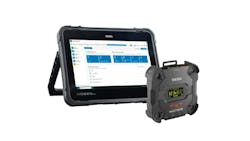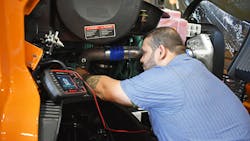Tools and tips to jump-start your diagnostic operations
Key takeaways:
- Diagnsotic software and tools are almost required equipment in today's shops as vehicles gain more sensors, modules, and computerized systems
- Diagnostic tools and platforms are helped by increased access to vehicle telematics and AI
- But to make these tools as efficient as possible, it helps to make sure you have the right combination of equipment between laptops, diagnostic scanners, and software
The number of sensors, modules, and computer-based systems on commercial vehicles continues to increase across every class with each new model year. This relentless technological advancement not only adds complexity—and several benefits—to operations but also creates more diagnostic challenges for shops. Compared to decades past, it’s like going from playing the game "Operation" to open heart surgery.
Maintenance teams are adept at adjusting to change, but shops have reported serious challenges in finding capable technicians in general, let alone ones who can decipher diagnostic trouble trees and perform root cause analysis. And to make matters worse, costs are climbing while the freight recession has pushed many fleets’ cash reserves to the brink.
As a result, shops have to do more with less to survive. And advanced diagnostic tools, which can access, interpret, and analyze vehicle data to enable faster resolutions, have become the maintenance equivalent of defibrillators. When used correctly, they can jump-start shop throughput and fleet uptime.
Shops that don’t leverage them, however, might not survive this challenging trucking transition.
“Without the diagnostic software, you’re dead in the water,” said Dan Carrano, vice president of fleet maintenance at A. Duie Pyle, a logistics carrier in the Northeast with over 1,800 power units. “It’s impossible [to complete a repair] without a diagnostic tool, and the frequency of use seems to continually increase as vehicles become more ingrained with technology.”
The capabilities of diagnostic tools have increased, evolving from simple fault readers to multifunctional platforms that integrate real-time remote diagnostics, artificial intelligence-driven fault analysis, and predictive insights, allowing technicians to pinpoint problems faster and reduce downtime.
“They now go beyond basic troubleshooting, using intelligent technology for predictive maintenance and comprehensive diagnostics across multiple vehicle systems and models, including electric and hybrid powertrains,” said Duane ‘Doc’ Watson, technical trainer at Bosch Mobility Aftermarket.
Drawing on more data
Modern diagnostic tools are now utilizing telematics, the Internet of Things, and AI and machine learning to predict potential failures before they occur while also increasing efficiency within the shop.
“Modern scanners access ECUs for complex diagnostics, use smart scanning and AI to speed up accurate problem identification, and offer real-time data tracking for pinpointing intermittent issues,” Watson explained.
Jimmy Singh, tech support lead for TEXA USA, said the quantity of diagnostic functions, activations, and adjustments that rely on stored data, as well as the required live data testing, only increases as newer, more complex system vehicle models are introduced. TEXA’s IDC6 platform features an AI Diagnostic Assist feature, which autonomously provides a service or repair diagnosis by comparing vehicle global scan data with known vehicle data records to suggest repair paths.
Bruno Gattamorta, chief commercial officer for Cojali USA, which provides Jaltest diagnostic tools, said the tighter integration and use of AI enable technicians to work with greater accuracy. “This leads to faster turnaround times for customers and, ultimately, a lower total cost of ownership for fleets,” he said.
Equipment Experts, Inc., an independent shop based in Lakewood, Washington, services multiple makes and models of equipment, including diesel trucks, forklifts, and liftgates. The shop has invested in several diagnostic tools, including Diesel Laptops with TEXA software and JPRO from Noregon, for its 12,000-sq.-ft. shop and 15 service trucks.
“All in all, we’ve probably got eight different laptops or scanners and 15 to 20 different software programs,” Joe LeMieux, operations manager for Equipment Experts, said. “Having resources and support is very important, especially for our mobile guys in the service trucks because they’re out there on their own.”
Jason Hedman, product manager at Noregon, said bidirectional testing has become necessary for many repairs, which can become a bottleneck for shops that lack sufficient tools. “It also speaks to the reason that the tech-to-tool ratio is tightening, because in order to complete those bidirectional tests, shops need tools like JPRO available for each technician to do so,” he explained.
One way that shops are addressing the tightening tech-to-tool ratio is by pairing comprehensive diagnostic applications with lighter, handheld devices. “Younger technicians are gravitating toward the smaller, lightweight devices. While they don’t have the full capabilities of a laptop-powered option, they can help technicians get the job started until a diagnostic laptop becomes available,” Hedman said.
A. Duie Pyle primarily relies on laptops and OEM software, which Carrano said provides the most flexibility for addressing complex issues. The fleet runs four different engine platforms, requiring different software from each manufacturer. Technicians also need software from Eaton to support transmissions and Bendix for brakes. “A lot of times, you need multiple laptops because of the multiple OEMs. The laptops can only support so many,” he said.
As time goes on, more systems become computer-controlled and require a laptop for a repair. “Hypothetically, a laptop that was used for six hours a day now could be used 12 hours a day because it is required more for diagnosing than it was previously,” Carrano said, adding that the fleet has increased the number of laptops available.
The ratio of tools to technicians has shifted from roughly one for every six techs a few years ago to about one for every three today, and it’s heading toward one-to-one, according to Gattamorta. “That reflects how essential these tools have become for keeping up with the growing complexity and electronics in modern vehicles,” he said.



